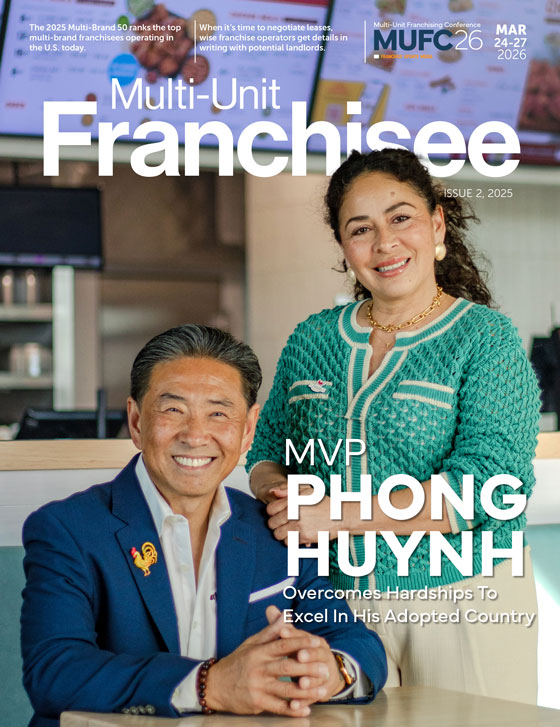Turnaround Time: Take a systematic approach with underperforming units

Over 10 years in franchising, Chanel Grant and her partners have owned franchise units that performed as well or better than expected and others that required extra attention.
“It’s interesting because different projects present different challenges, right?” says Grant, co-owner of six Tropical Smoothie Cafe units, three Hand & Stone Massage and Facial Spa locations, and one Vio Med Spa. “Sometimes, what worked to turn one project around doesn’t work for another project. You do that exact same formula, and for whatever reason, this market or this project is different.”
Grant is in business with her mother, Toya Evans, and sister, Lauren Williamson. Together, they own Healthy Living Ventures. When dealing with an underperforming unit, their philosophy is to dig in and look for answers. The owners and their team members brainstorm solutions, reach out to fellow franchisees to see what has worked for others, and connect with franchisors.
“I’m constantly challenged in that I have to continuously innovate and continuously think outside the box because it isn’t always very cookie-cutter,” Grant says. “You’re buying the blueprint and the business model, but your specific demographics, your market, the different competitive fields, and all of that play a role in how you carry out that blueprint. That’s why I try to never get comfortable. I’m always thinking of what tools and innovative resources I can add to make us successful.”
Brooke Wilson, president of Lead Dog Ventures, oversees Two Men and a Truck territories in Atlanta and the Triangle area of North Carolina. She’s also acquired, built, and sold multiple Two Men and a Truck franchises over the years. Along the way, she dealt with underperforming units and considers them a natural part of life as a multi-unit franchisee.
“I believe nearly everyone has worked in an underperforming business at some point in their life. The difference is whether they recognize it and take initiative to learn from it,” Wilson says. “Even in high school, working at a family-owned shaved ice and ice cream shop, I found ways to improve efficiency. In college, I helped build and manage a bar from the ground up, balancing the demands of operations with the financial expectations of investors. Those experiences shaped my approach to business, teaching me that success isn’t about avoiding challenges but about responding to them swiftly and effectively.”
While it can be necessary to sell underperforming units in some situations, franchisees succeed over the long haul by becoming turnaround artists, using all the skills and resources at their disposal to get locations on track.
“The key is approaching challenges with data-driven decision-making, a commitment to strong leadership, and a culture that embraces continuous improvement,” Wilson says.
KPIs
When buying new locations, Chris Patel prefers to purchase underperforming units because he can get them for a relatively low multiple. He’s the co-owner and COO of Pie Investments, which operates 70 Papa Johns, 50 Dunkin’, and two Baskin-Robbins. In 2020, Patel and his partners bought four Papa Johns locations in New Jersey, and he was tapped to manage them.
“When we look at a particular distress situation, it’s a multi-pronged approach for me,” Patel says. “We do a review of the KPIs in place: Is there a service issue? Is it an issue of an unengaged owner? Is it an issue of culture? Or is it an issue of just lack of marketing?”
As the number of Pie Investments’ Papa Johns units has grown over the past five years, Patel goes back to what he learned from operating those first four units. It was definitely a learning curve.
“We possibly bought the worst set of four stores you could buy in the system,” he says. “I was able to get in there, train people, work myself, and cover shifts. That’s how I was able to see this impact. The first four sets of restaurants had all these core issues I just pointed out. It had a tired owner, the culture was not there, the lack of capital was there, and marketing was not there. That’s how buying potentially the worst set of stores helped us understand how to implement a strategy and see growth.”
The work is ongoing. Patel said that not every Papa Johns is performing as well as it could, but the portfolio as a whole is doing well. His wife, Pre Patel, is vice president of operations, and she oversees area directors who implement the turnaround plan that he developed.
“All of them worked in our restaurants,” he says. “I guess the career progression for them came through by working for us within our assets. Some of these employees worked for the same owners who retired and were ready to throw the white flag in. Sometimes, it’s not an employee issue; it’s an issue of motivation and having the right culture in place.”
While Grant keeps the pressure on herself to ensure her units are operating as they should, she also relies on data from her franchisors to let her know how her units compare to those owned by other franchisees.
“We like to use benchmarks. We’re lucky enough that the brands that we’re involved in really provide you with cohort data,” she says. “Someone who opened the same time as you, how are they doing? It would be unfair to benchmark ourselves against a spa or something that’s been open for 13 years. We use the data that we get weekly from our franchisors. We like to benchmark ourselves against spas that opened around the same time as us.”
If a location is underperforming in relation to its cohort, it’s time to dive in and look at the data and KPIs to get to the root of the problem. There could be a staffing issue or a lack of marketing. She recently initiated a technology overhaul designed to boost store performance.
“I’m building out an AI platform that will help us get to leads faster,” Grant says. “I am never comfortable. I’m constantly like, ‘What’s next? What else can we be doing? How can we take this to the next level?”
Working with franchisors
She and her fellow franchisees communicate with each other and swap ideas. She’s also worked with her franchisors to deal with issues. When a franchisee has underperforming stores, franchisors might not provide a complete solution, but they can be a crucial part of an overall turnaround plan.
“I don’t know that I ever brought a problem to the franchisor and they fixed it on their own,” Grant says. “I think it’s been like a team effort of saying, ‘Hey, let’s come up with a solution for this.’ And we’re able to. One of the great things about being in a franchise is that they want you to succeed just as bad as you want to succeed.”
Mitch Cohen is a Jersey Mike’s Subs and Sola Salon Suites franchisee, and he’s been involved with franchising since operating Baskin-Robbins locations in the 1980s. During a spring meeting of the International Franchise Association, he and his partners, Tom Baber and Tamra Kennedy, started talking about the state of franchising and saw a need for their expertise. They joined together to create PerforMax Franchisee Advisors, a consulting firm focused on helping franchisees and franchisors improve their bottom lines.
“We brainstormed and said, ‘Wouldn’t it be great if we put together a company to help the industry and the field people work with underperforming franchisees?’” Cohen says. “We thought that there would be a niche in the industry for us to go out and do that.”
The company is usually hired by emerging brands and large multi-unit franchisees. When a call comes in, PerforMax starts by talking to the executive team and department heads at the franchisor. That’s followed by delving into the brand’s FDD and other paperwork and essentially doing due diligence as a potential franchisee.
“Then we talk to the franchisees, and we roll up a report that will be included in our services if they choose to sign us on. Otherwise, that report they pay for separately,” he says. “The report is really, for lack of a better term, a SWOT analysis from the outside of where their opportunities are. Then we construct a proposal with the franchisor to figure out exactly what they want to tackle between the franchisees and the brand.”
Early in the process, Cohen looks for low-hanging fruit, easy changes that can help alleviate some of the pressures on struggling franchisees or operators in multi-unit systems. For example, if a brand’s packaging is expensive, it could inspire testing different options to find a less expensive supplier.
“The franchisees could be more profitable right away, so you’re putting money back in their pockets,” he says. “That’s one example. Another would be menu maintenance. When was the last time a franchisor in the food industry really evaluated their menu?”
Working with franchisees
Pragmatic suggestions that streamline operations do double duty by reducing costs and smoothing the way forward for more changes. When it’s time to meet with the operator of an underperforming unit, PerforMax can show that it’s already improved the situation.
“That’s the first win,” Cohen says. “Most of this is a relationship business. Yes, things are broken, but it breaks down when somebody’s not making money or they don’t believe in the system. We come in, roll up our sleeves, and help them believe in the system and show them how to make money.”
One part of PerforMax’s service is to coach field teams on how to focus on operations. Cohen says that a drop in sales usually starts with a breakdown in operations.
“If you have operational excellence, then you look to see if sales data is showing a downward trend in sales,” he says. “Then you have to look at location. What happened in the area? Is the road closed? Are they building a new highway? Did the big university shut down? Whatever it is.”
If everything else is working well, it could be a proximity issue. Two different units might observe the franchisor’s radius restriction, but Cohen says a border drawn with a pen doesn’t always reflect what’s happening on the ground.
“The traffic pattern is different depending on your product,” he says. “Store B might be more convenient than my store was. I become underperforming because my sales are down, but everything else is good.”
Making a change
Wilson with Two Men and a Truck says some situations aren’t salvageable. She says that knowing when to make a change is as important as knowing how to fix a struggling location.
“Selling isn’t a failure; it’s a strategic decision,” she says. “If reinvesting in the unit doesn’t generate a clear path to profitability, reallocating resources to stronger-performing businesses or locations is the smarter business move.”
When considering the viability of a unit, Wilson looks at three factors:
- Sustained financial struggles. If a unit has been consistently underperforming despite strategic interventions and the market doesn’t support profitability, it may be time to exit.
- Leadership or operational limitations. If the local labor pool lacks the right talent or the unit struggles with retention despite strong incentives, sustaining improvement becomes difficult.
- Market and competitive landscape. Some locations are no longer viable due to shifting demographics, economic downturns, or strong competition.
Cohen adds that if the decision is made to close a location, it’s in the franchisor and franchisee’s best interest to get as much value out of a sale as possible. Deciding to sell can spur operators to invest in their units to make them more attractive to potential buyers.
“Nobody wants to be promoted to customer, and nobody wants to see all that investment go down the drain either,” Cohen says.
Thinking win-win makes as good sense at the end of the franchisee-franchisor relationship as it does in the beginning.
“If the location isn’t worth saving, I want to help that franchisee get some money back out of his or her investment,” Cohen says. “We’ll want to concentrate on that and say, ‘Look, it’s better if you work with us and we get you to a point where you can put this place up for sale and get a reasonable value for it before the brand asks you to walk away. Everybody wins.”
Multi-Unit advantage
As Pie Investments’ portfolio has grown, Patel has found that consolidation of units in a particular market serves as a hedge against underperforming units. Economies of scale kick in, which can cut costs for supplies, marketing, and labor.
“Let’s say that before it was four franchises, but now it’s one. Now, it would be a single franchisee owning 10 locations in one geographical area,” Patel says. “We can unify the offer mix. We can do joint marketing and joint mailers. Consolidation of a portfolio is a big key in order for you to turn something around or even see some level of growth or progress. Being able to control an entire market area goes a long way in terms of what strategies you use.”
Patel and Pie Investments are focused on growth and have no plans to slow down. That’s the way they like it.
“I hope we don’t have to shut a unit down in the future,” he says. “We want to be here for the long haul and ensure we only grow, not go backwards.”
Grant and her partners share the sentiment. They try to be extremely selective when choosing to expand. While due diligence on the front end isn’t a guarantee of success, Grant says it’s a good start. Even so, unexpected difficulties arrive. They might not be pleasant, but Grant, who never wants to get complacent, sees problems as potential gifts.
“On a positive note, it kind of makes us shake things up a little bit,” Grant says. “I mean, let’s come up with a solution.”
A Repeatable Process
According to franchising veteran Brooke Wilson, a structured turnaround approach requires a repeatable process and the right tools:
- Financial and operational audit. Conduct a deep dive into P&L statements, payroll efficiency, and pricing models to spot inefficiencies.
- Customer experience insights. Analyzing surveys, complaints, and reviews helps identify service gaps.
- Sales and marketing strategy. Are leads converting at the expected rate? Are we optimizing digital marketing efforts?
- Talent and training. Employee engagement and competency are critical. If leadership at the unit is weak, retraining or replacing key personnel may be necessary.
- Tech utilization. Ensure the unit is effectively leveraging CRM software, management tools, and tracking systems.
- Accountability and follow-up. Set up weekly progress tracking, benchmarks, and clear consequences if improvements aren’t met.
Share this Feature
Recommended Reading:
| ADVERTISE | SPONSORED CONTENT |
FRANCHISE TOPICS
- Multi-Unit Franchising
- Get Started in Franchising
- Franchise Growth
- Franchise Operations
- Open New Units
- Franchise Leadership
- Franchise Marketing
- Technology
- Franchise Law
- Franchise Awards
- Franchise Rankings
- Franchise Trends
- Franchise Development
- Featured Franchise Stories
FEATURED IN

Multi-Unit Franchisee Magazine: Issue 2, 2025
| ADVERTISE | SPONSORED CONTENT |

$250,000
$400,000





 The multi-unit franchise opportunities listed above are not related to or endorsed by Multi-Unit Franchisee or Franchise Update Media Group. We are not engaged in, supporting, or endorsing any specific franchise, business opportunity, company or individual. No statement in this site is to be construed as a recommendation. We encourage prospective franchise buyers to perform extensive due diligence when considering a franchise opportunity.
The multi-unit franchise opportunities listed above are not related to or endorsed by Multi-Unit Franchisee or Franchise Update Media Group. We are not engaged in, supporting, or endorsing any specific franchise, business opportunity, company or individual. No statement in this site is to be construed as a recommendation. We encourage prospective franchise buyers to perform extensive due diligence when considering a franchise opportunity.